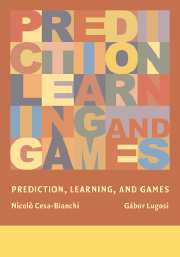Book contents
- Frontmatter
- Contents
- Preface
- 1 Introduction
- 2 Prediction with Expert Advice
- 3 Tight Bounds for Specific Losses
- 4 Randomized Prediction
- 5 Efficient Forecasters for Large Classes of Experts
- 6 Prediction with Limited Feedback
- 7 Prediction and Playing Games
- 8 Absolute Loss
- 9 Logarithmic Loss
- 10 Sequential Investment
- 11 Linear Pattern Recognition
- 12 Linear Classification
- Appendix
- References
- Author Index
- Subject Index
Preface
Published online by Cambridge University Press: 03 December 2009
- Frontmatter
- Contents
- Preface
- 1 Introduction
- 2 Prediction with Expert Advice
- 3 Tight Bounds for Specific Losses
- 4 Randomized Prediction
- 5 Efficient Forecasters for Large Classes of Experts
- 6 Prediction with Limited Feedback
- 7 Prediction and Playing Games
- 8 Absolute Loss
- 9 Logarithmic Loss
- 10 Sequential Investment
- 11 Linear Pattern Recognition
- 12 Linear Classification
- Appendix
- References
- Author Index
- Subject Index
Summary
… beware of mathematicians, and all those who make empty prophecies.
St. Augustine, De Genesi ad Litteram libri duodecim. Liber Secundus, 17, 37.Prediction of individual sequences, the main theme of this book, has been studied in various fields, such as statistical decision theory, information theory, game theory, machine learning, and mathematical finance. Early appearances of the problem go back as far as the 1950s, with the pioneering work of Blackwell, Hannan, and others. Even though the focus of investigation varied across these fields, some of the main principles have been discovered independently. Evolution of ideas remained parallel for quite some time. As each community developed its own vocabulary, communication became difficult. By the mid-1990s, however, it became clear that researchers of the different fields had a lot to teach each other.
When we decided to write this book, in 2001, one of our main purposes was to investigate these connections and help ideas circulate more fluently. In retrospect, we now realize that the interplay among these many fields is far richer than we suspected. For this reason, exploring this beautiful subject during the preparation of the book became a most exciting experience – we really hope to succeed in transmitting this excitement to the reader. Today, several hundreds of pages later, we still feel there remains a lot to discover. This book just shows the first steps of some largely unexplored paths. We invite the reader to join us in finding out where these paths lead and where they connect.
- Type
- Chapter
- Information
- Prediction, Learning, and Games , pp. xi - xiiPublisher: Cambridge University PressPrint publication year: 2006

